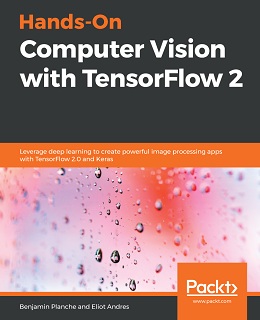Hands-On Computer Vision with TensorFlow 2
eBook Details:
- Paperback: 372 pages
- Publisher: WOW! eBook (May 30, 2019)
- Language: English
- ISBN-10: 1788830644
- ISBN-13: 978-1788830645
eBook Description:
Hands-On Computer Vision with TensorFlow 2: A practical guide to building high performance systems for object detection, segmentation, video processing, smartphone applications, and more
Computer vision solutions are becoming increasingly common, making their way into fields such as health, automobile, social media, and robotics. This book will help you explore TensorFlow 2, the brand new version of Google’s open source framework for machine learning. You will understand how to benefit from using convolutional neural networks (CNNs) for visual tasks.
Hands-On Computer Vision with TensorFlow 2 starts with the fundamentals of computer vision and deep learning, teaching you how to build a neural network from scratch. You will discover the features that have made TensorFlow the most widely used AI library, along with its intuitive Keras interface. You’ll then move on to building, training, and deploying CNNs efficiently. Complete with concrete code examples, the book demonstrates how to classify images with modern solutions, such as Inception and ResNet, and extract specific content using You Only Look Once (YOLO), Mask R-CNN, and U-Net. You will also build generative adversarial networks (GANs) and variational autoencoders (VAEs) to create and edit images, and long short-term memory networks (LSTMs) to analyze videos. In the process, you will acquire advanced insights into transfer learning, data augmentation, domain adaptation, and mobile and web deployment, among other key concepts.
- Create your own neural networks from scratch
- Classify images with modern architectures including Inception and ResNet
- Detect and segment objects in images with YOLO, Mask R-CNN, and U-Net
- Tackle problems faced when developing self-driving cars and facial emotion recognition systems
- Boost your application’s performance with transfer learning, GANs, and domain adaptation
- Use recurrent neural networks (RNNs) for video analysis
- Optimize and deploy your networks on mobile devices and in the browser
By the end of the book, you will have both the theoretical understanding and practical skills to solve advanced computer vision problems with TensorFlow 2.0.


![Beginning Server-Side Application Development with Angular [eLearning]](https://www.ebookee.ws/wp-content/uploads/2018/08/Beginning-Server-Side-Application-Development-with-Angular-eLearning.jpg)
![How to Visualize Data with D3 [Video]](https://www.wowebook.org/wp-content/uploads/2021/07/How-to-Visualize-Data-with-D3-Video.webp)
